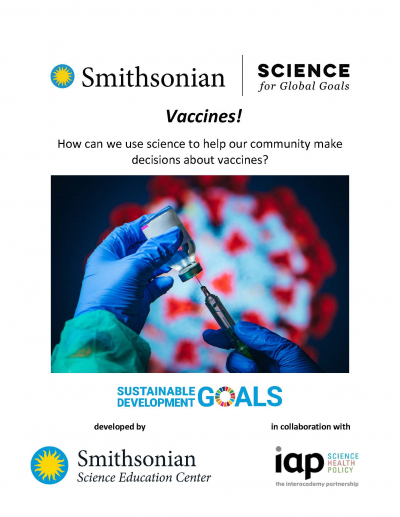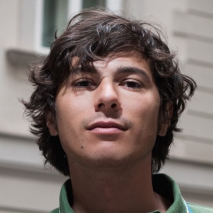


As part of Smithsonian Science for Global Goals, the Smithsonian Science Education Center, in collaboration with the World Health Organization and the InterAcademy Partnership —a partnership of 140 national academies of science, engineering and medicine— has developed “Vaccines! How can we use science to help our community make decisions about vaccines?,” a community response guide designed for children and teens between the ages of 8 and 17. Through the “Vaccines!” community response guide, young people will learn about the concerns of their community in order to communicate accurate, helpful, and trusted information about vaccines.
The guide features eight tasks that incorporate investigations and hands-on science to help students discover, understand and take action. Students will learn about the science of vaccines throughout history; how vaccines work and are developed; examine issues of equity, access, and misinformation; and develop an action plan for addressing concerns within their communities.
“Our community response guides for vaccines and COVID-19 are a part of the Smithsonian’s Vaccines & US initiative, where you can find trustworthy resources and information about vaccines,” said Dr. Carol O’Donnell, director of the Smithsonian Science Education Center. “As youth around the globe engage with the activities in these guides, they will be able to share their knowledge with their community, create tangible ways to help their community make informed decisions in this challenging time and understand the best places to find additional information on the topic.”
“The Smithsonian Science Education Center makes science exciting and approachable for children and youth all over the world and encourages them to explore the how and the why of things around them,” said Dr. Soumya Swaminathan, chief scientist at WHO. “The Smithsonian Science for Global Goals project uses an innovative methodology where children and youth learn by doing and have to discover the answers themselves. Understanding the relationship between human beings and the environment will help us live in harmony and also prepare for future pandemics. With all the myths and misconceptions out there, it is important for children and youth to understand the nature of this pandemic and what can be done to prevent future pandemics from happening.”
“It is so important for children—wherever they are in the world—to develop their scientific understanding and rational thinking,” said Professor Volker ter Meulen, president of IAP. “Only by being able to make rational decisions based on the best science and evidence can any of us adjust our behavior to keep ourselves and our families safe from infections.”
“Vaccines! How can we use science to help our community make decisions about vaccines?” is also available in Spanish and can be downloaded for free from https://ssec.si.edu/vaccines.
The Smithsonian Science Education Center will host webinars on May 5 and May 13 to support educators to use this content with their students. To learn more and register for these webinars visit: https://ssec.si.edu/event/vaccines.
The Smithsonian Science Education Center (SSEC) is transforming K–12 Education Through Science in collaboration with communities across the globe. The SSEC is nationally and internationally recognized for the quality of its programs and its impact on K–12 science education.
The World Health Organization provides global leadership in public health within the United Nations system. Founded in 1948, WHO works with 194 Member States, across six regions and from more than 150 offices, to promote health, keep the world safe and serve the vulnerable. Our goal for 2019–2023 is to ensure that a billion more people have universal health coverage, to protect a billion more people from health emergencies and provide a further billion people with better health and well-being. For updates on COVID-19 and public health advice to protect yourself from coronavirus, visit www.who.int and follow WHO on Twitter, Facebook, Instagram, LinkedIn, TikTok, Pinterest, Snapchat, YouTube.
Under the umbrella of the InterAcademy Partnership (IAP), more than 140 national, regional and global member academies work together to support the vital role of science in seeking evidence-based solutions to the world’s most challenging problems. In particular, IAP harnesses the expertise of the world’s scientific, medical and engineering leaders to advance sound policies, improve public health, promote excellence in science education and achieve other critical development goals. See www.interacademies.org and follow IAP on Twitter https://twitter.com/IAPartnership and YouTube https://www.youtube.com/channel/UCZl-b7akbFF81bKBZsc8YbQ.
